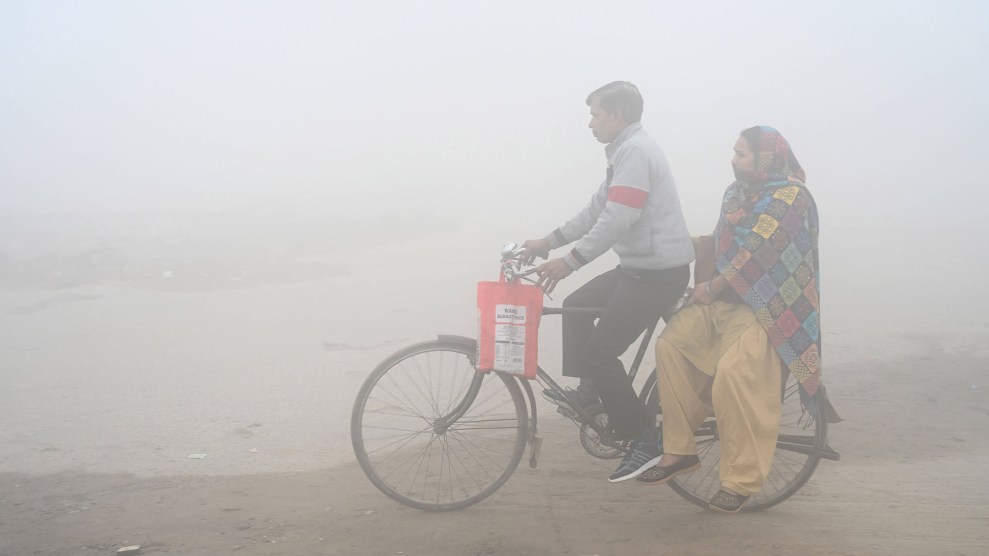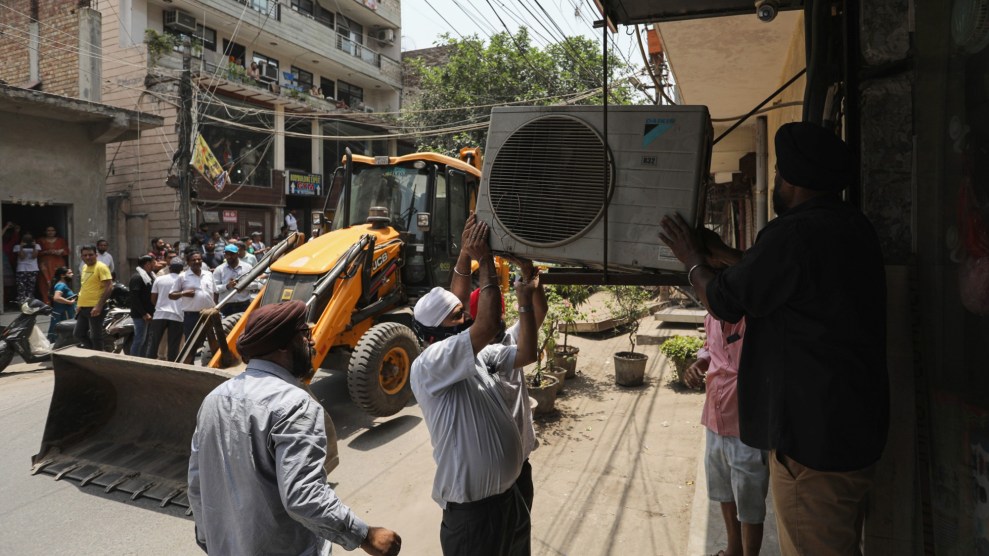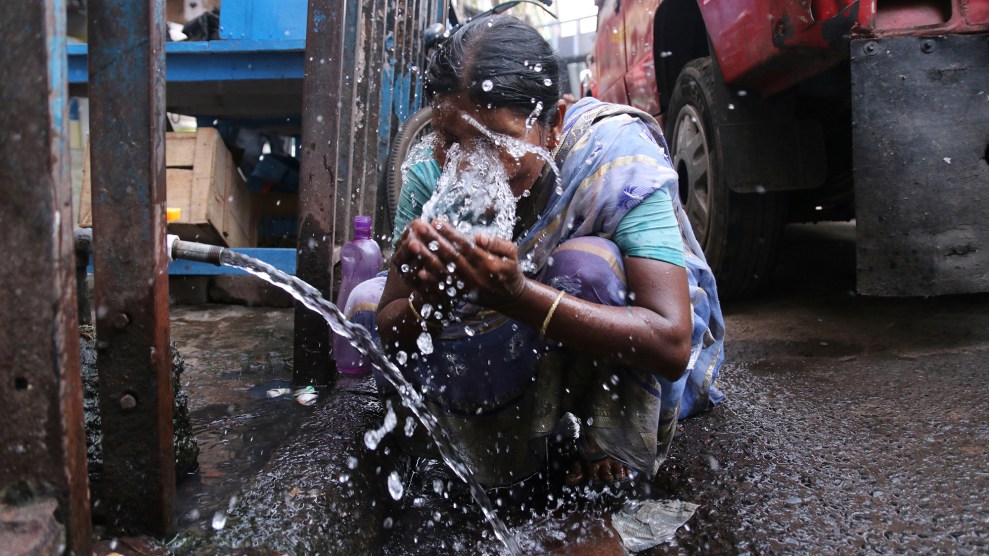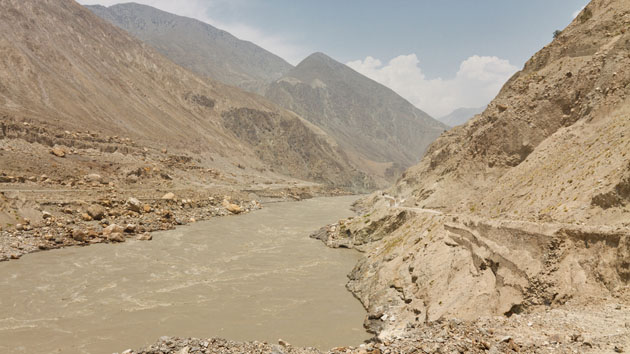
The air quality in the national capital remained in the severe plus category for the second consecutive day in Greater Noida, India, November 2024.Imago/ZUMA
This story was originally published by Vox.com and is reproduced here as part of the Climate Desk collaboration.
India and Pakistan are losing ground to a common deadly enemy. Vast clouds of dense, toxic smog have once again shrouded metropolises in South Asia. Air pollution regularly spikes in November in the subcontinent, but this year’s dirty air has still been breathtaking in its scale and severity. The gray, smoky pollution is even visible to satellites, and it’s fueling a public health crisis.
Last week, officials in the Punjab province in Pakistan imposed lockdowns on the cities of Multan, population 2.1 million, and Lahore, population 13.7 million, after reaching record-high pollution levels. “Smog is currently a national disaster,” senior Punjab provincial minister Marriyum Aurangzeb said during a press conference last week. Schools shut down, restaurants closed, construction halted, highways sat empty, and medical staff were recalled to hospitals and clinics.
Across the border in India, the 33 million residents of Delhi this week are breathing air pollution that’s 50 times higher than the safe limit outlined by the World Health Organization (WHO). The choking haze caused 15 aircraft to divert to nearby airports and caused hundreds of delays. Students and workers were told to stay home.
Global health authorities say air pollution has reduced the average life expectancy by 2.3 years, and contributes to almost 7 million deaths annually.
Despite all the disruption, air pollution continues to spike year after year after year.
Why? The dirty air arises from a confluence of human and natural factors. Construction, cooking fires, brick kilns, vehicles, and burning leftovers from crop harvests are all feeding into the toxic clouds. The Himalaya and Hindu Kush mountains to the north of lower-lying areas like Lahore and Delhi hold the smog in place. In the winter, the region experiences thermal inversions, where a layer of warm air pushes down on cool winter air, holding the pollution closer to the ground.
As populations grow in South Asia, so will the need for food, energy, housing, and transportation. Without a course correction, that will mean even more pollution. Yet history shows that air pollution is a solvable problem. Cities like Los Angeles and Beijing that were once notorious for dirty air have managed to clean it up. The process took years, drawing on economic development and new technologies. But it also required good governance and incentives to cut pollution, something local officials in India and Pakistan have already demonstrated can clear the air. The task now is to scale it up to higher levels of government.
There’s no shortage of science showing how terrible air pollution is for you. It aggravates asthma, worsens heart disease, triggers inflammation, and increases infection risk. It hampers brain development in children and can contribute to dementia in adults.
On average, air pollution has reduced life expectancies around the world by 2.3 years, more than tobacco. It contributes to almost 7 million deaths per year, according to WHO, about one in nine deaths annually. It sucks trillions of dollars out of the global economy.
The toll is especially acute in South Asia. Air pollution drains 3.9 years of life in Pakistan. In India, it steals 5.3 years. For workers who spend their days outdoors—delivery drivers, construction crews, farm laborers—the damage is even higher. Many residents report constant fevers, coughs, and headaches.
Despite the well-known dangers and the mounting threat, it remains a persistent problem.
Part of the challenge of improving air quality is that air pollution isn’t just one thing; it’s a combination of hazardous chemicals and particles that arise in teeming metropolises in developing countries.
One of the most popular metrics around the world for tracking pollution is the Air Quality Index, developed by the US Environmental Protection Agency. The index is not a measurement of any one pollutant, but rather the risk from a combination of pollutants based on US air quality standards. The main villains are ground-level ozone, carbon monoxide, sulfur dioxide, nitrogen dioxide, and particles. The particles are subcategorized into those smaller than 10 microns (PM10) and smaller than 2.5 microns (PM2.5). (Earlier this year, the EPA modified the way it calculates the AQI, so numbers from this year are not an apples-to-apples comparison to levels from previous years.) The tiny particles are pernicious because they penetrate deep into the lungs and trigger breathing problems.
“I think the most surprising, interesting, and scary thing, honestly, is seeing the levels of pollution in areas that haven’t been monitored before.”
An AQI below 50 is considered safe to breathe. Above 200, the air is considered a health threat for everyone. At 300, it’s an emergency. In Delhi, the AQI this last week reached 1,185. Lahore reached 1,900 this month. If a person breathes this air for over 24 hours, the exposure is roughly equivalent to smoking 90 cigarettes in a day.
However, air pollution poses a threat long before it’s visible. “Your eye is not a good detector of air pollution in general,” said Christi Chester Schroeder, the air quality science manager at IQAir, a company that builds air quality monitoring instruments and collects pollution data. “The pollutant that you have to be really careful about in terms of not being able to see it but experiencing it is ozone. Ozone levels can be extremely high on sunny days.”
IQAir has a network of air quality sensors across South Asia, including regions like Lahore and Delhi. The company tracks pollution in real time using its own sensors as well as monitors bought by schools, businesses, and ordinary people. Their professional-grade air monitors can cost more than $20,000 but they also sell consumer air quality trackers that cost $300. Both sources help paint a picture of pollution.
Many schools and businesses across South Asia have installed their own pollution monitors. The US maintains its own air quality instruments at its consulates and embassies in India and Pakistan as well.
Schroeder noted, however, that IQAir’s instruments are geared toward monitoring particles like PM2.5 and don’t easily allow a user to make inferences about concentrations of other pollutants like sulfur oxides and where they’re coming from. “When you’re looking at places that have a really big mixture of sources—like you have a mixture of transportation and fires and climate inversion conditions—then it gets to be much murkier and you can’t really sort of pull it apart that way,” Schroeder said.
Air quality monitors in India and Pakistan show that air pollution can vary over short distances—between neighborhoods or even street by street—and that it can change rapidly through the day. Nearby bus terminals, power plants, or cooking fires contribute a lot to local pollution, but without tracking systems in the vicinity, it can be hard to realize how bad the situation has become.
“I think the most surprising, interesting, and scary thing, honestly, is seeing the levels of pollution in areas that haven’t been monitored before,” Schroeder said.
Another complication is that people also experience pollution far away from where it’s produced. “This automatically creates a big governance challenge because the administrator who is responsible for providing you clean air in your jurisdiction is not actually the administrator who is governing over the polluting action,” said Saad Gulzar, an assistant professor of politics and international affairs at Princeton University.
Take crop stubble burning, which accounts for up to 60 percent of the air pollution in the region this time of year. In late fall, farmers in northern India and Pakistan harvest rice and plant wheat. With little time between the reaping and sowing, the fastest and cheapest way for many farmers to clear their fields of leftover stems, leaves, and roots is to burn it. The resulting smoke then wafts from rural areas into urban centers.
Motivating officials to act at local, regional, and national levels is a key step in reducing air pollution.
The challenge is that farmers and urbanites are different political constituencies, and it’s hard to demand concessions from the former to benefit the latter. It has led to bitter political fights in both countries and between them. Farmers also point out that the reason they have so little time between crops is because of water conservation laws: To cope with groundwater depletion, officials in India imposed regulations to limit rice planting until after monsoon rains arrive in the early summer to top up reservoirs. Delaying planting means delaying harvest, hence the rush to clear their fields.
Both India and Pakistan have even gone as far as to arrest farmers who burn crop stubble, but there are millions of farmers spread out over a vast area, stretching enforcement thin. However, local efforts to control smoke from crop burning have proven effective when local officials are motivated to act.
Gulzar co-authored a study published in October in the journal Nature, looking at air pollution and its impacts across India and Pakistan. Examining satellite data and health records over the past decade, the paper found that who is in charge of a jurisdiction plays a key role in air pollution—and could also be the key to solving it.
When a district is likely to experience pollution from a fire within its own boundaries, bureaucrats and local officials take more aggressive action to mitigate it, whether that’s paying farmers not to burn stubble, providing them with tools to clear fields without fires, or threatening them with fines and arrest. That led fires within a district to drop by 14.5 percent and future burning to decline by 13 percent. These air pollution reductions led to measurable drops in childhood mortality. On the other hand, if the wind is poised to push pollution from crop burning over an adjacent district, fires increase by 15 percent.
The results show that simply motivating officials to act at local, regional, and national levels is a key step in reducing air pollution and that progress can begin right away.
But further air quality improvements will require a transition toward cleaner energy. Besides crop burning, the other major source of air pollution across India and Pakistan is fossil fuel combustion, whether that’s coal in furnaces, gas in factories, or diesel in trucks. These fuels also contribute to climate change, which is already contributing to devastating heat waves and flooding from torrential monsoons in the region. Both countries have made major investments in renewable energy, but they are also poised to burn more coal to feed their growing economies.
At the COP29 climate change conference in Baku, Azerbaijan, India was asking wealthier nations to contribute more money to finance clean energy within its borders and to share technologies that will help reduce greenhouse gas emissions and enhance air quality.
Solving the air pollution crisis in India and Pakistan will take years, and it’s likely to get worse before it gets better. But there are lifesaving measures both countries can take now.
















